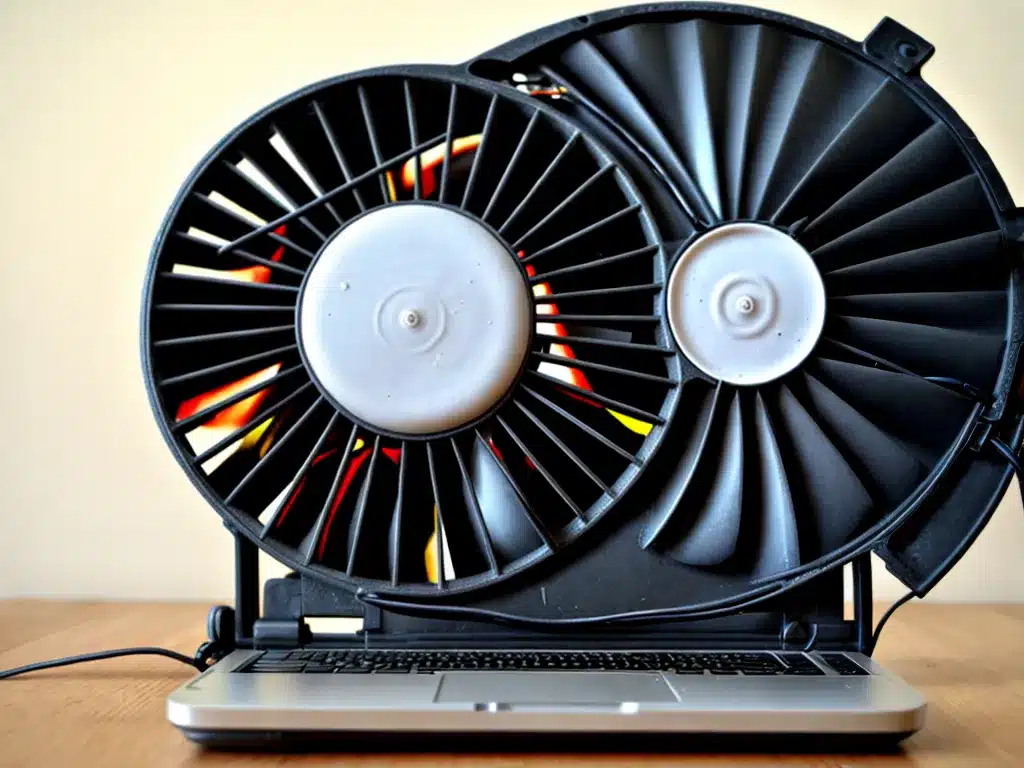
An overheating laptop can be frustrating and dangerous for your device. Excessive heat causes performance issues, crashes, and hardware damage over time. The most common cause of laptop overheating is a buildup of dust and debris in the cooling fans and air vents. Fixing an overheating laptop fan is possible with some basic cleaning and maintenance.
Why Laptops Overheat
Laptops generate a lot of heat from components like the CPU, GPU, RAM, and hard drive. Fans and heatsinks are used to dissipate this heat and keep the internal components at safe operating temperatures.
Several factors can cause a laptop to overheat:
-
Dust Buildup – Dust, pet hair, and debris can clog the internal air vents and fans over time. This restricts airflow and causes components to heat up.
-
Thermal Paste – The thermal paste between the CPU/GPU and heatsink can become old and ineffective. This reduces heat transfer.
-
Blocked Vents – Using laptops on beds, sofas, and other soft surfaces can block air intake vents underneath.
-
Resource Intensive Tasks – High CPU/GPU usage during gaming, video editing, etc generates more heat.
-
Faulty Hardware – Issues with the CPU fan, heat pipes, or temperature sensors can prevent proper cooling.
Signs of Overheating and Effects
Detecting an overheating laptop fan early and fixing the issue is important. Here are some signs:
-
Loud fan noise – Fans will spin faster and louder to try dissipating heat.
-
Random shutdowns – Components getting too hot will trigger emergency shutdowns to prevent damage.
-
Throttling – CPU/GPU clock speeds are reduced to lower temps, hurting performance.
-
Crashes – Excess heat leads to more crashes and freezes.
-
Overheating warnings – Messages about high temps from BIOS or OS.
-
Hot surfaces – Feeling high heat on the bottom case, keyboard, etc.
Prolonged overheating degrades laptop components like CPU, RAM, motherboard. It can shorten the laptop’s lifespan if left unchecked.
Cleaning Vents and Fans
Accumulated dust and debris are the most common culprits behind an overheating laptop and noisy fans. Here are some steps to clean the vents and fans:
Gather Supplies
-
Small vacuum cleaner with brush attachment
-
Compressed air canister
-
Cotton swabs
-
Small Phillips head screwdriver
Clean the Vents
First use the vacuum cleaner to clean visible dust buildup around the intake and exhaust vents located along the sides, bottom, rear, etc. Be very gentle around any vents.
Next, use compressed air to dislodge and blow out fine debris from the air vents. Hold the can upright and spray air in short bursts.
Finish by gently swabbing around vents with cotton swabs to pick up remaining dust.
Clean the Fans
Cleaning the internal fans requires opening up the laptop’s bottom case. This gives access to the CPU and GPU heatsinks and fans.
Use the following steps:
- Turn off and unplug the laptop. Remove any batteries.
- Locate and remove screws from bottom panel.
- Pry up and remove bottom case.
- Use compressed air to blow away dust from fans and heatsink fins.
- Swab the fans, heat pipes, and vents with cotton swabs.
- Re-apply fresh thermal paste between CPU and heatsink if needed.
- Reattach bottom panel and screws.
This comprehensive cleaning will remove built up dust that’s overheating the laptop.
Additional Troubleshooting Tips
If overheating continues after a thorough cleaning, try these additional troubleshooting steps:
-
Update BIOS, chipset, and management engine firmware – Old firmware can have temperature regulation issues.
-
Reseat internal components – Remove and firmly reseat RAM, wireless cards, SSDs, etc. Loose connections cause overheating.
-
Test hardware – Use a hardware monitor to check CPU, GPU, and hard drive temperatures when overheating occurs. Determine if a specific component is the issue.
-
Replace thermal paste – Removing old dried up thermal paste between the CPU and heatsink, then applying fresh paste can lower temperatures.
-
Use a cooling pad – External USB cooling pads with fans help dissipate heat during intense usage like gaming.
-
Check for software issues – Malware and problematic software can increase CPU usage. Clean install the OS if needed.
-
Repair/replace – For older laptops, it may be time to replace aged thermal components like heat pipes and fans. Or replace the laptop if it’s too expensive.
Preventing Overheating Issues
Implementing proper maintenance and usage habits prevents overheating problems from developing:
-
Clean the laptop vents monthly using compressed air. More often if you have pets.
-
Update BIOS and firmware to latest stable versions for optimal fan control.
-
Avoid using laptop on beds, sofas and other soft surfaces that restrict airflow.
-
Take short breaks during lengthy intensive tasks to let components cool down.
-
Monitor temps with hardware software. Take action if CPU or GPU exceed 90 °C.
-
Reapply high quality thermal paste every 2 years between CPU and heatsink.
-
Consider using laptop cooling pads for heavy gaming or video editing.
Proper cleaning and maintenance keeps the laptop operating at optimal temperatures, extends hardware lifespan, and avoids failures.












